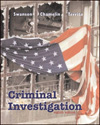Motor vehicle theft is one of the most significant issues facing law enforcement today. In 2000, there was one motor vehicle theft every 20 seconds. Prior to 2000, the number of thefts had been dropping for about 10 years. With the collapse of communism and the opening of free market economies in eastern Europe, however, auth theft has become an enormous problem. This, coupled with the increase in fraudulent insurance claims and other factors, has created a real challenge for law enforcement. In addition, investigating motor vehicle thefts can be difficult and in some cases very complex for several reasons. When investigating vehicle theft, officer must determine the reason for the theft. Vehicles may be stolen temporarily, for example, for use in the commission of other crimes such as robberies or drive-by shootings, after which the vehicles are abandoned. Other reasons for theft can include joyriding, professional theft, or fraudulent schemes. Professional thieves use a variety of means such as chop shops, stripping, salvage switch, and export to other countries to dispose of stolen vehicles. Once a vehicle has been chopped or stripped, trying to identify particular stolen vehicles and/or parts can be extremely difficult. However, this seemingly formidable task has been made easier in part by the creation of standardized vehicle identification number systems. Finally, investigators are often faced with situations where the perpetrators are not strangers or professional thieves but the owners themselves. Given limited law enforcement resources, vehicle theft may not be considered a top priority. Nonetheless, investigators have many major resources and organizations at their disposal. An overview of several of these resources, such as the National Insurance Crime Bureau and the American Association of Motor Vehicle Administrators, and the information they can provide is presented in this chapter. While the issue of motor vehicle theft is the main topic of this chapter, also addressed are theft or other high-value items, such as heavy equipment and farm equipment; commercial vehicle and cargo theft; marine theft; and the theft of aircraft and avionics. Prevention programs that can help minimize the theft of motor vehicles and other items are also discussed in the chapter. |



 2002 McGraw-Hill Higher Education
2002 McGraw-Hill Higher Education